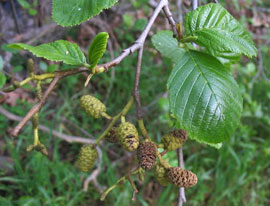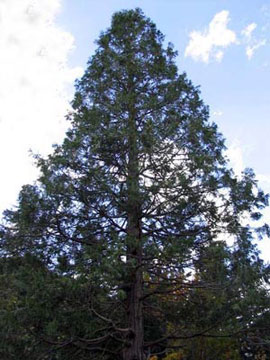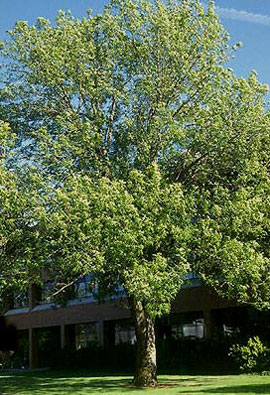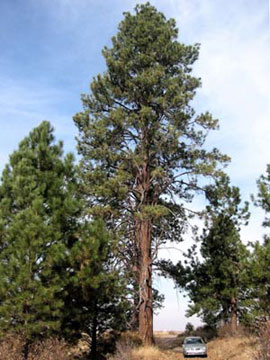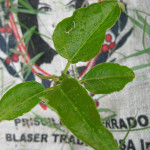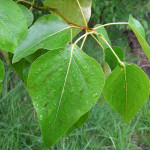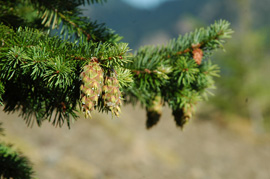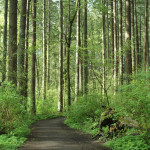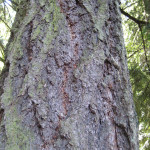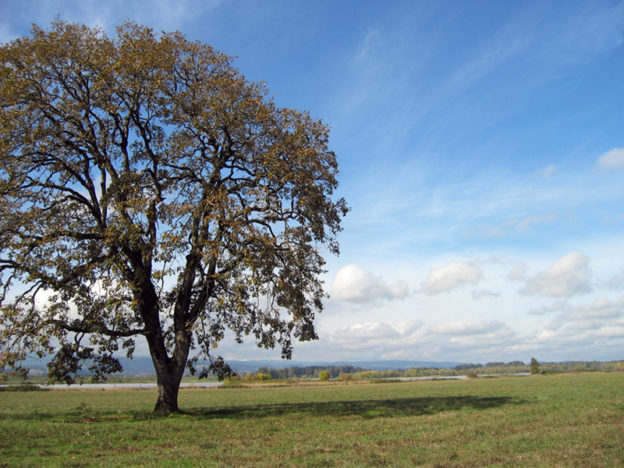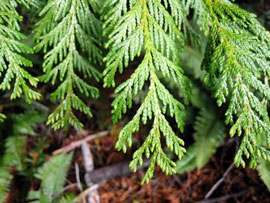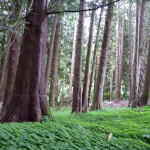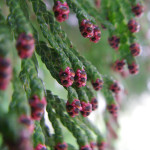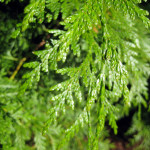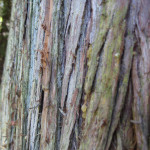Pseudotsuga menziesii
Douglas fir is one of the most common evergreen trees in the our region. It grows fast and can tolerate many soil types. This is a good tree to plant in groups as a windbreak, or at the edge of wooded areas, as it needs plenty of space.
The bark is thin, smooth, and gray on young trees, and thick and corky on older trees. The needle-like leaves are spirally arranged and 2-3.5 cm long, and a bud at the tip of most branches distinguishes it from other evergreens. Douglas fir foliage has a noticeable sweet fruity-resinous scent, particularly if crushed. The 2-4 inch long cones are green in spring, maturing to orange-brown in the autumn 6-7 months later. The male cones disperse yellow pollen in spring.
Many kinds of wildlife depend on Douglas fir for winter forage. Mice, voles, shrews, chipmunks, pine siskins, song sparrows, golden-crowned sparrows, white-crowned sparrows, red crossbills, dark-eyed juncos, and purple finches all eat the abundant seeds. Black-tailed deer and elk will eat the seeds late in winter when other forage is scarce. The Douglas squirrel harvests and caches great quantities of Douglas fir cones for later use, and the squirrels will also eat mature pollen cones, the inner bark, terminal shoots, and tender young needles.
Fun facts: Douglas fir (Pseudotsuga menziesii) is neither a true fir, nor is it a hemlock (hence the Latin name, *Pseudo*tsuga). It is its own genus altogether. It is also the second-tallest evergreen in the world after the Coast Redwood. Trees 200-250 feet or more in height and 5-6 feet in diameter are common in old growth stands, and heights of 300-400 feet were reported by early lumbermen. It commonly lives more than 500 years and occasionally more than 1,000 years.
- Light Requirements: Full Sun, Part Shade
- Water Requirements: Dry, Moist, Seasonally Wet
- Ease of Growing: Easy to grow
- Growth Rate: Fast
- Spreads: No
- Wildlife Support: Birds or Mammals
- Fire-resistant: Yes
- Edible: No
- Mature Height: 120-240ft
- Mature Width:30ft
Quercus garryana
The iconic Quercus garryana, also known as Garry oak and Oregon white oak, is a drought tolerant tree that can also tolerate prolonged seasonal flooding. It can often grow on sites that are too dry for other tree species. These slow-growing trees are smaller at maturity than many Pacific Northwest trees, growing eventually to a maximum size of 65-80 ft tall and wide. They have deep tap roots and widely spreading roots, making them resistant to wind-throw. Mature trees growing in open areas develop broad oval crowns, making them excellent shade trees.
The leaves are deciduous, 3-6″ long and 2-5″ broad, with 7-9 deep lobes on each side. The flowers are catkins, and the fruits are small acorns about 1″ long with shallow, scaly cups.
Over 200 species of wildlife benefit from Oregon white oaks, including pollinators such as Fender’s blue, Taylor’s checkerspot, Mardon skipper, Islad marble, and the Oregon silverspot. The Oregon white oak is also the only known food for the caterpillars of Propertius duskywing butterflies and a leaf-mining moth. Deer, bear, raccoons, squirrels, and many small mammals eat the acorns, as do wild turkeys, band-tailed pigeons, woodpeckers, jays, and others.
Oregon white oaks also have significant cultural value for many Native tribes. For all these reasons, Oregon white oaks and their associated prairie habitats are the focus of many regional conservation efforts.
-

-

- Oregon white oak (Quercus garryana) has thick, fire-resistant bark. Younger trees are more vulnerable.
-

- Light Requirements: Full Sun
- Water Requirements: Dry, Moist
- Ease of Growing: Moderate
- Growth Rate: Slow
- Spreads: No
- Wildlife Support: Pest-eating Insects, Birds or Mammals
- Fire-resistant: Yes
- Edible: No
- Mature Height: 25-70ft
- Mature Width:30-60ft
Thuja plicata
Western redcedar (Thuja plicata) is a large evergreen conifer treasured not only for its beauty, but also its wildlife value and cultural significance going back to time immemorial.
Mature Western redcedars can get 115 – 230 feet tall. The flat, elegant sprays of foliage makes the tree look like it is draped with lace, especially when dusted with frost or snow. The cones are slender with overlapping scales. This tree is actually part of the cypress family, and not a true cedar (just like Douglas-fir is not a true fir).
Western redcedars make excellent wildlife habitat, providing food and shelter for many species. Rosners hairstreak butterflies are only found in association with this tree, as they depend on it for reproduction and food for their young. Large and small mammals feed on the leaves and inner bark for most of the year; squirrels and other rodents use its shredded bark for winter nests; and many birds and small mammals find shelter and nest sites in red cedar cavities.
Western redcedar is a iconic tree of the Pacific Northwest. If you have a shady, moist spot large enough for it to thrive, this is a beautiful and valuable addition to any forested landscape.
- Light Requirements: Full Sun, Part Shade, Full Shade
- Water Requirements: Moist, Seasonally Wet
- Ease of Growing: Easy to grow
- Growth Rate: Moderate
- Spreads: No
- Wildlife Support: Birds or Mammals
- Fire-resistant: No
- Edible: No
- Mature Height: 100-200ft
- Mature Width:30ft

